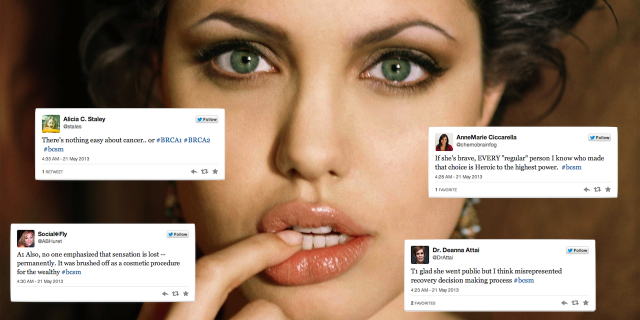Angelina Jolie’s opinion piece in The New York Times , May 14, 2013, has taken social media by storm. If you haven’t heard, she shared her decision to have a double mastectomy after learning that she “carries a faulty gene BRCA1.”
To learn how women and men who have had breast cancer feel about the op/ed, we turned to the Breast Cancer Social Media twitter chat #BCSM. #BCSM “meets” virtually every Monday at 9pm EST on tweetchat.com. These men, women and caregivers have been conversing over twitter since July 4, 2011. They’ve shared, supported, cried and vented over breast cancer. These breast cancer patients on social media welcome newcomers to their chat and their numbers continue to increase.
“There’s nothing easy about cancer…or BRCA1 BRCA2,” said one participant when the discussion began.
Praise for Ms. Jolie’s bravery peppered with concern about the article filled the twitter-verse. There are several important pieces of information that one needs to know when reading Ms. Jolie’s message. First, she is a woman who is at high risk for breast cancer because her mother had ovarian cancer–diagnosed at a young age (46)– and died at a young age (56) of the disease. For these reasons, her physicians counseled her to do the genetic testing that motivated her decision.
Yes! Counseling is key. RT @joannpushkin: A1 Thought that decision should be made in consult w/ geneticist was not made clear enough.#bcsm
— Lisa Greaves (@LGG1) May 21, 2013
It is important to know that Ms. Jolie consulted a geneticist even though this may not have been made clear.
According to Dr. Kenneth Offit, chief of the Clinical Genetics Service at Memorial Sloan-Kettering Cancer Center, only about five percent of women with breast cancer have this hereditary, high risk form and those are the people who benefit from genetic testing. If a woman has breast or ovarian cancer at an early age, or a woman or man has a family history of ovarian or breast cancer, they should be tested. Men who test positive are at risk for breast and prostate cancer and may develop the more aggressive form of prostate cancer.
A woman with a BRCA1 or BRCA2 mutation has between 16 and 60 percent lifetime risk of ovarian cancer, according to the National Cancer Institute. The risk for the rest of the population is 1.7 percent.
#BCSM participants are very aware of how little information and support is available for those with other cancers.
“I wish AJ had used her microphone to focus on the ovarian cancer risks…the dark BRCA1 secret that gets no press,” one participant stated.
Although we have screenings for breast cancer, there are no good tests to catch ovarian cancer early. Most ovarian cancer is caught as Stage III or Stage IV—at this stage, the cancer has metastasized or spread to other parts of the body. The only time Dr. Offit has seen early stage, curable ovarian cancer is when women with BRCA1 or BRCA2 mutations have had their ovaries removed. Thus, if someone tests positive for BRCA1 or BRCA2 mutation, Dr. Offit recommends removal of the ovaries after child-bearing years.
“I just feel bad that after they remove the ovaries too she is in for major depression,” one participant relates.
When reading the editorial, it is important to remember that not everyone has a great outcome or experience with the surgery. As another tweeter noted,
@jpete008 T1: yes, reconstructive surgery isn’t zoom, bam, zippedty do dah.#bcsm
— Jody Schoger (@jodyms) May 21, 2013
Another stated that she was “glad she went public but I think misrepresented recovery decision making process.”
Again, Ms. Jolie’s description of the ease of the surgical experience intrigued participants. “One part of her op-ed that made me bristle was that she made a BMX seem easy peasy.I was out of it for six weeks afterwards.”
“@jpete008: @broken_boobie “two tiny little scars…” #BCSM” I snorted at that. 😉
— BrokenBoobie (@broken_boobie) May 21, 2013
Side effects were also minimized in the Ms. Jolie’s piece.
I think reconstruction gets pushed pretty hard, but that the side effects & potential probs go largely unmentioned to patient. #bcsm
— CJ CorneliussenJames (@CJMeta) May 21, 2013
Included in this critique was the comment, “Also, no one emphasized that sensation is lost — permanently. It was brushed off as a cosmetic procedure for the wealthy.”
Both oophorectomy and double breast mastectomy have post-operative risks and side effects.
Identifying BRCA1 and BRCA2 genes and the mutations associated with breast cancer and ovarian cancer are causing difficult medical decisions. The double mastectomy is becoming more common not only in women with cancer in one breast but also in those who do not have a cancer diagnosis, like Ms. Jolie.
Yet Dr. Offit says that there are many different options for women to consider besides the surgical option, including taking Tamoxifen on a preventative basis.
Even with the surgery there is a risk of breast cancer, it is much smaller but still there. This is because, even with the most radical surgery, some breast cancer cells remain.
Today, other mutations responsible for hereditary breast cancer are known and tested in addition to BRCA in families with high suspicion of a genetic causality. In years to come, after clinical trials and testing, these genetic changes may add more information to women’s understanding of their personal risk. And they will increase the need for counseling and informed decision-making.
If she’s brave, EVERY “regular” person I know who made that choice is Heroic to the highest power.#bcsm
— AnneMarie Ciccarella (@chemobrainfog) May 21, 2013







I believe that all the sarcastic comments should stop towards her . She may be rich and famous however she is another woman living with the horrible fear of Cancer. The gene is in her family. Under the circumstances she did what she felt was correct for her own preservation. She also has biological daughters, imagine what her thoughts may be,
Fear has no price tag it is a genuine emotion. Alli…….